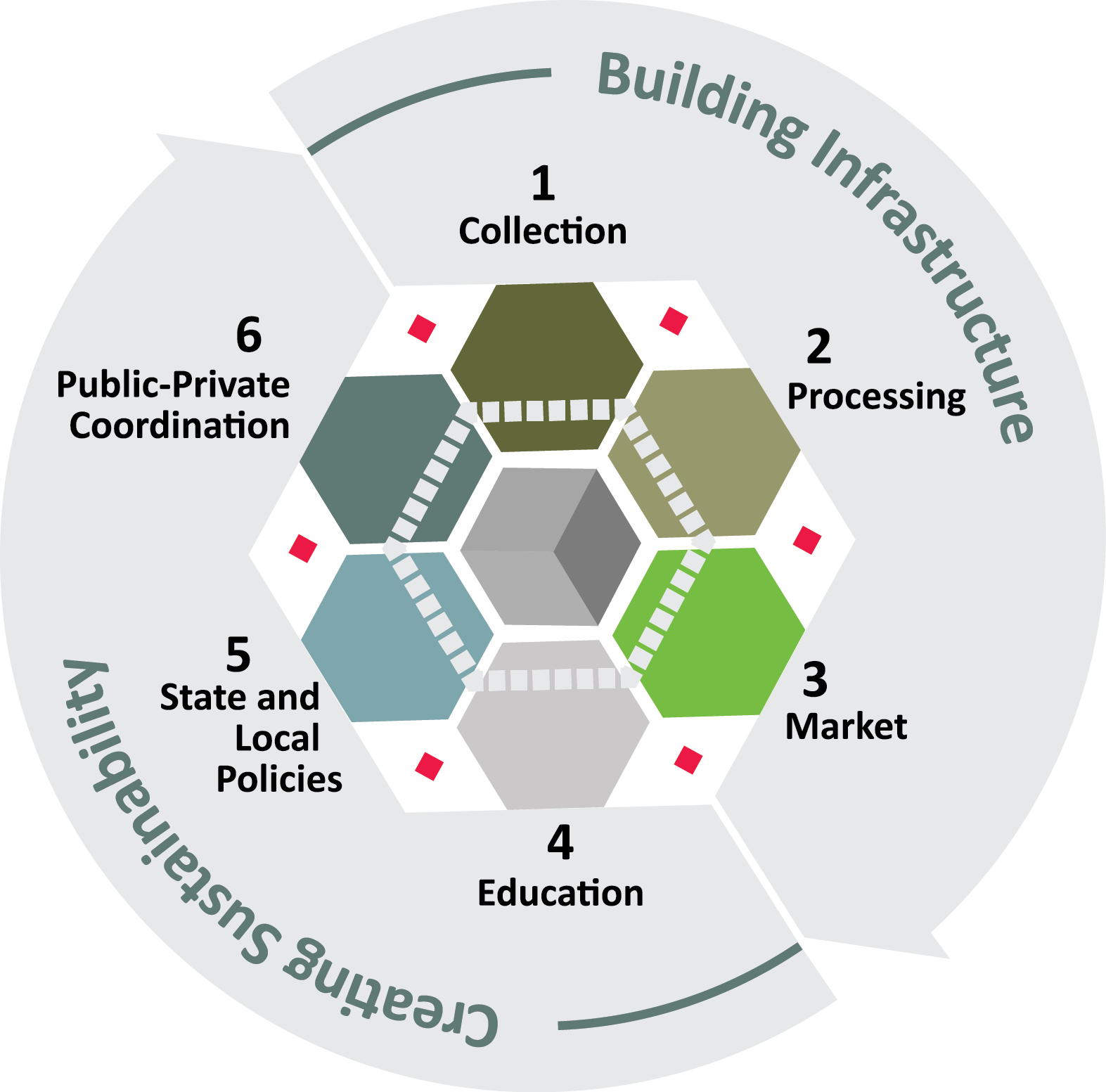Waste Recovery: Aligning Around Best Practices
A Look Back and A Glimpse Forward
Anyone who has looked at the national recycling rate for the United States in recent years is bound to use words like “stagnant” or “flat.” Lots of discussion has taken place at national, state and local levels on how to break out of these doldrums and take recovery to the next level.
On the positive side, this last year saw a number of significant developments that hold promise for stronger recovery:
- The Recycling Partnership, a collaborative industry effort with millions of dollars in backing, led by Curbside Value Partnership, is showing how industry funded grant “interventions” can leverage and align local focus on implementing best practices for recovery in collection (carts), education and engagement, working closely with federal, state and local agencies.
- The Closed Loop Fund, another collaborative industry effort, with a $100M bankroll, is demonstrating how low and no interest loans can drive innovation in the development of recovery infrastructure with their first projects under development and moving towards announcement as I write this.
- The Carton Council continues to demonstrate how cross competitor industry collaboration can drive real change in nationwide recycling infrastructure as they reach 52% access for gable top and aseptic cartons across the country – from only 18% just five years ago.
- Waste Management released its “Recycle Often, Recycle Right” campaign to address the challenge of the evolving recycling bale and contamination as it impacts MRF operation and the underlying economics of the processing stage of our recycling infrastructure.
- The Food Service Packaging Institute is leading campaigns directed at the challenges of finding market driven recycling solutions for the broad range of packaging being used in the food and hospitality industry, including launching the Foam Recycling Coalition.
- Walmart continued to effectively use its supply chain to drive change with its spring announcements of commitments to recycling content in a range of its retail products.
These are just a few of many initiatives across the country led by all sectors – state agencies that are rewriting their waste and recycling plans, local governments that are pursuing high recovery strategies for both recyclables and organics, and service providers who are investing in the next generation of the infrastructure that will make stronger recovery possible.
While promising, time will be the test for these initiatives and realization of their potential impact. What’s impressive to me is their positioning to take on the challenge of national scaling – bringing best practices for recovery shown in figure 1 to each and every household, business and institution across the country. What worries me is our nation’s tendency to over complicate things, to head off into lofty debates that run down proverbial rabbit holes (e.g. the current “dirty MRF” dialogue) instead of bringing a hard and practical focus on the basics – the so called “blocking and tackling” of recycling.
After all it really is quite simple! We just have to make a shared commitment to move forward – with alignment. RRS’s 30 years of experience validated by client based research has documented the positive correlation between the six components shown in figure 1 and successful municipal recycling performance – measured in pounds per household diverted.
The first three components focus on the infrastructure of recycling – the value chain for recovering recyclables:
1. community access to effective and convenient collection systems for a common basket of recyclables;
2. a technologically robust recycling facility that is able to sort and then go to market with those recyclables; and
3. strong end markets for those recyclables.
The second three components focus on making this infrastructure sustainable for the long term:
4. strong and consistent community education and engagement that support participation;
5. supporting state and local policies that encourage recycling; and
6. effective public and private coordination that funds and delivers these municipal recycling services.
All six components must be present and at least three or four of the components need to include “best practice” approaches for success to be realized. These best practice approaches can vary from community to community and from region to region – but all six components must work together as a system to drive effective municipal recycling performance.
So what do we need to do in 2015 to build on 2014’s progress?
We need action on the following fronts:
- Brands, retailers and the packaging industry need to step up the level of active engagement in pre-competitive industry collaborations like the Recycling Partnership and the Closed Loop Fund – with serious commitments of funding. Sitting on the sideline is not acceptable.
- Public and private waste and recycling service providers need to continue to invest in universal access for recycling across the country – rolling recycling carts, for example, have proven to be the single most effective step a community or hauler can take to increase recycling rates measured in pounds per household.
- Incentives like accelerated depreciation need to be developed as part of our federal tax law to address the challenges faced by our MRF and end markets where nearly continuous equipment upgrades are needed to stay ahead of the rapidly changing recycling stream. The equipment solutions are there – capital investment is the challenge.
There are more action items, but perhaps most important is industry support for the simple policies at the state, local (and even national) levels that can support effective recycling. I’m not talking about EPR or deposit laws but instead the “blocking and tackling” of good recycling – universal access, performance goals, mandatory recycling, disposal bans and strong education and engagement. Industry waffling on support for these simple policies here late in 2014 is unfortunate – a real example of the potential missed opportunity that causes anxiety for the future. However, if the smart money will continue to invest in the strong and sensible programs, like those mentioned above, then we finally may be able to break through our national recycling rate doldrums!
Where do you think 2015 will lead? Tell us in the comments section below.

